Tourist Attractions in Patiala
The Qila Mubarak
The Qila Mubarak complex stands in 10-acre ground in the heart of the city and contains the main palace or Qila Androon (Inner Fort), the guesthouse or Ran Baas and the Darbar Hall. Outside the Qila are the Darshani Gate, a Shiva temple, Patiala qila mubarak and bazaar shops which border the streets that run around the Qila and sell precious ornaments, colorful hand-woven fabrics, ‘PATIALA JUTIEs’ and bright ‘PARANDIs’.
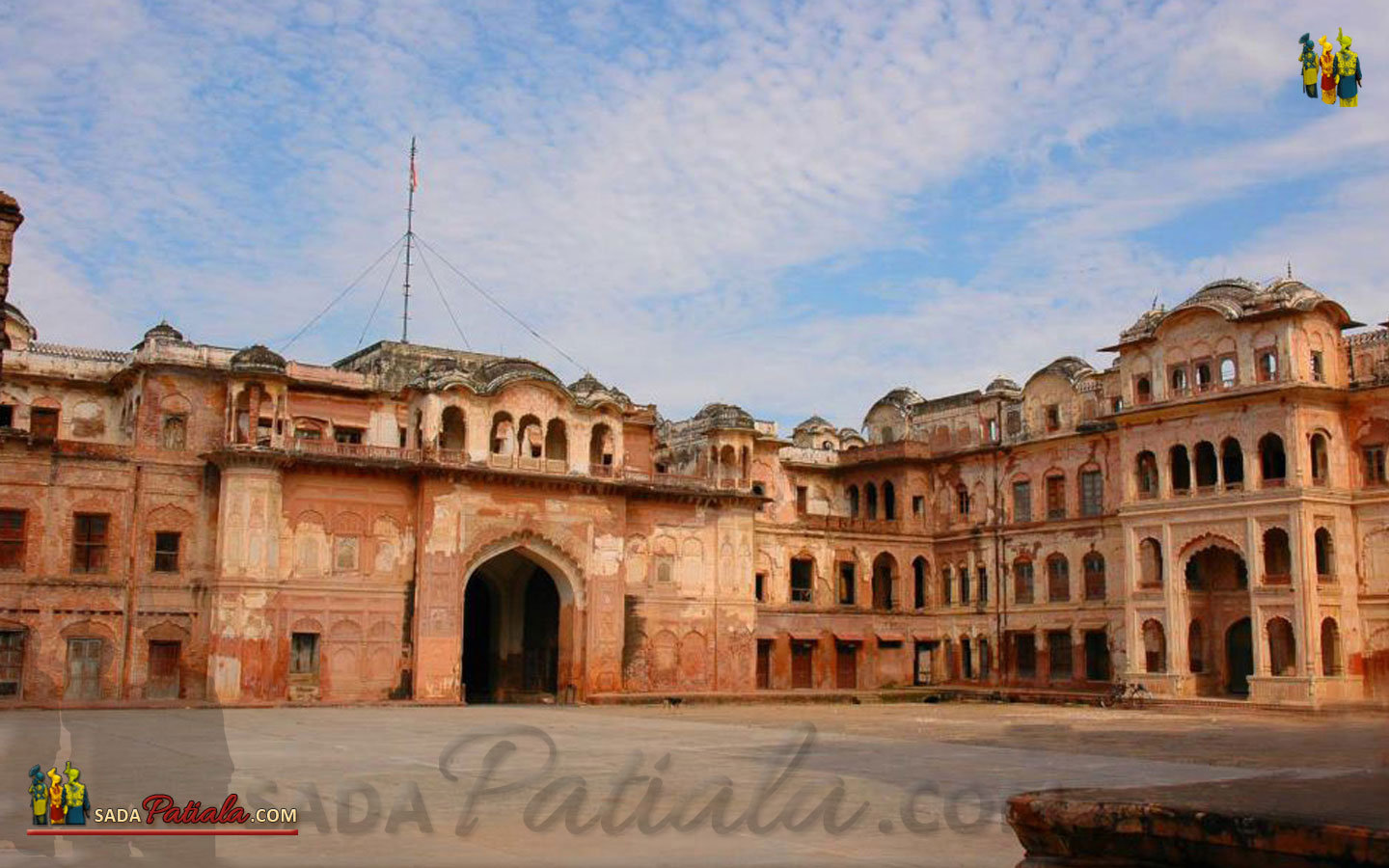
In Qila Androon the entrance is through an imposing gate. The architectural style of this palace is a synthesis of late Mughal and Rajasthani. The complex has 10 courtyards along the north - south axis and each courtyard is unique in size and character, some being broad, others very small and still others mere slits in the fabric of building.Though the Androon is a single interconnected building, it is spoken of as a series of palaces. Each set of rooms makes a cluster around a courtyard, and each carries a name: Sheesh Mahal, Toshakhana, Jalau Khana, Chand Mahal, Rang Mahal, Treasury and Prison. Ten of the rooms are painted with frescoes, or decorated intricately with mirror and gilt. In a tiny portion of the complex is a little British construction with Gothic arches, fire places made of marble and built-in toilets perched on the Mughal Rajasthani roof!. Burj Baba Ala Singh even today has a fire smoldering ever since the time of Baba Ala Singh, along with a flame brought by him from Jwalaji.
Rang Mahal and Sheesh Mahal contain a large no. of frescoes, most of which were made under Maharaja Narender Singh. Within the Qila Mubarak are 16 painted and mirror-worked chambers. For instance, the Darbar room is illustrated with Vishnu avatars and stories of courage or generosity, the ladies' chamber with illustrations from famous romantic epics, and two other chambers with illustrations of the qualities of a good or bad king. The frescoes, among the finest painted in India in the second half of the 19th century are evidently the work of artists from Rajasthani, Pahari and Avadhi traditions.
Ran-Baas was probably a guest house. It has an imposing gateway and two courtyards, both with fountains and small tanks. A room in the first courtyard-with painted walls and a gilt throne-was probably for semi -formal audience. A few pavilions are set among painted walls on the upper storey. Facing each other across the courtyard are two exquisite chambers, one painted and the other decorated with mirror work.
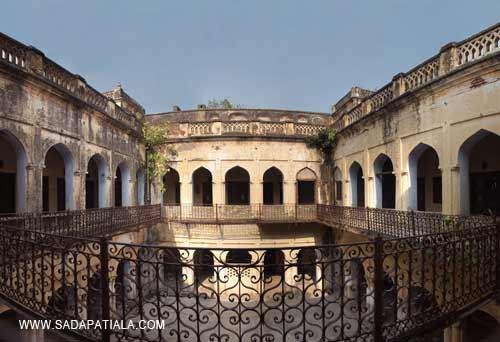
Darbar Hall (Divan Khana) used for large audiences and important public occasions, the Darbar has been converted into a museum displaying dazzling chandeliers and armor, including the sword and dagger of Guru Gobind Singh and Nadir Shah's sword. The hall was built on a high plinth over a network of tunnels which were service conduits. The facade gives the impression of a double-storey building, with 'upper storey' windows and a balcony at the first floor level, but the delicately worked wood-and-glass doors open into a huge 15m-high chamber. At the far end is a raised platform, where the Maharaja sat . The wooden frame work of the ceiling holds decorated Plaster-of Paris tiles painted in Arabic style and the ceiling is hung with a fabled collection of chandeliers.
Jalau Khana and Sard Khana (Cool Room), Both were much later constructions. The Jalau Khana is a small, two storeyed building with a central hall in late Colonial style, where regalia were displayed. The Sard Khan provided an escape from the summer heat. A deep well inside it acted as a wind tunnel, bringing cool air into the ground-floor rooms and the basement. Outside, there is a formal garden with waterways and fountains.
Lassi Khana (Kitchen) is another small, two-storeyed building with a central courtyard and a well.It adjoins the Ran-bass, and a passage links it to the Qila Androon. Local residents say that at one time this kitchen had the capacity to serve nearly 35,000 people every day, but following an economy drive, the Lassi Khana restricted itself to serving only a modest 5,000 people.
Shahi Samadhan, where Maharaja Rajinder Singh once built a garden, now holds cenotaphs of erstwhile rulers, looked after by a mahant.
Moti Bagh Palace
The Moti Bagh Palace constructed in 1847 by Maharaja Narendra Singh at a cost of Rs. 5 lakhs; Maharaja Narendra Singh was as great a builder as Swai Jai Singh of Jaipur. The Moti Bagh Palace was designed on the pattern of Shalimar Gardens of Lahore with terraces, water channels, 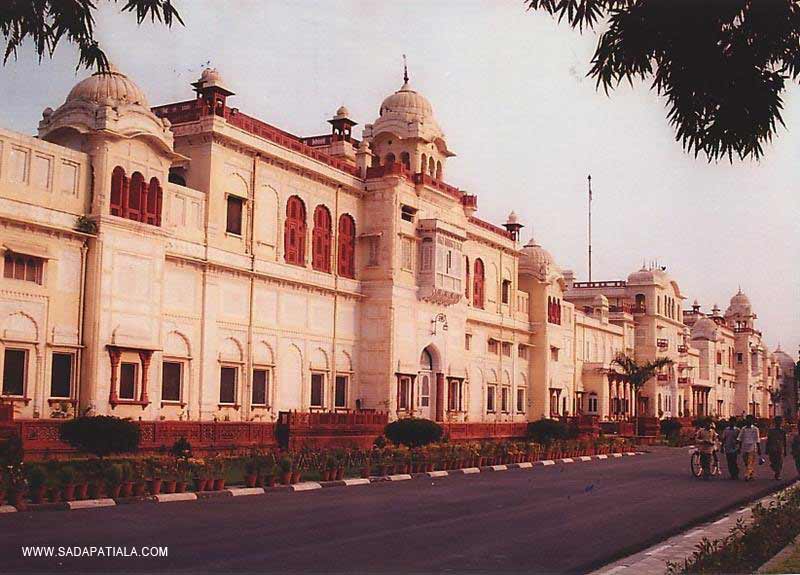 Moti Bagh Palace Sheesh Mahal and beautiful garden. Patiala motibagh_palaceIt is a four storeyed structure with massive stone-walls, arched openings, filtered and ornamental grills and crowning domes. The rear part of the palace has been developed into an amusement park, which offers many attractions to the young and the old alike. In the foreground of the Sheesh Mahal, there is a huge tank with two towers on both sides. Along with it is the suspended rope bridge popularly known as Lakshman Jhula, which connects the palace with the Bansar Ghar housing the Natural History Gallery. Here the stuffed animals and birds are displayed. The rest of the palace now houses the most prestigious Subhash Chander Bose National Institute of Sports.
Moti Bagh Palace Sheesh Mahal and beautiful garden. Patiala motibagh_palaceIt is a four storeyed structure with massive stone-walls, arched openings, filtered and ornamental grills and crowning domes. The rear part of the palace has been developed into an amusement park, which offers many attractions to the young and the old alike. In the foreground of the Sheesh Mahal, there is a huge tank with two towers on both sides. Along with it is the suspended rope bridge popularly known as Lakshman Jhula, which connects the palace with the Bansar Ghar housing the Natural History Gallery. Here the stuffed animals and birds are displayed. The rest of the palace now houses the most prestigious Subhash Chander Bose National Institute of Sports.
 Moti Bagh Palace Sheesh Mahal and beautiful garden. Patiala motibagh_palaceIt is a four storeyed structure with massive stone-walls, arched openings, filtered and ornamental grills and crowning domes. The rear part of the palace has been developed into an amusement park, which offers many attractions to the young and the old alike. In the foreground of the Sheesh Mahal, there is a huge tank with two towers on both sides. Along with it is the suspended rope bridge popularly known as Lakshman Jhula, which connects the palace with the Bansar Ghar housing the Natural History Gallery. Here the stuffed animals and birds are displayed. The rest of the palace now houses the most prestigious Subhash Chander Bose National Institute of Sports.
Moti Bagh Palace Sheesh Mahal and beautiful garden. Patiala motibagh_palaceIt is a four storeyed structure with massive stone-walls, arched openings, filtered and ornamental grills and crowning domes. The rear part of the palace has been developed into an amusement park, which offers many attractions to the young and the old alike. In the foreground of the Sheesh Mahal, there is a huge tank with two towers on both sides. Along with it is the suspended rope bridge popularly known as Lakshman Jhula, which connects the palace with the Bansar Ghar housing the Natural History Gallery. Here the stuffed animals and birds are displayed. The rest of the palace now houses the most prestigious Subhash Chander Bose National Institute of Sports.Sheesh Mahal
Punjab, the smiling soul of India has been aptly nicknamed the city of gardens and palaces. The imperial palaces of Punjab accentuate the beauty of the rambling farmlands and majestic temples. Sheesh Mahal is one such exquisite palace in Patiala that flaunts the flamboyant grandeur of the erstwhile maharajahs.
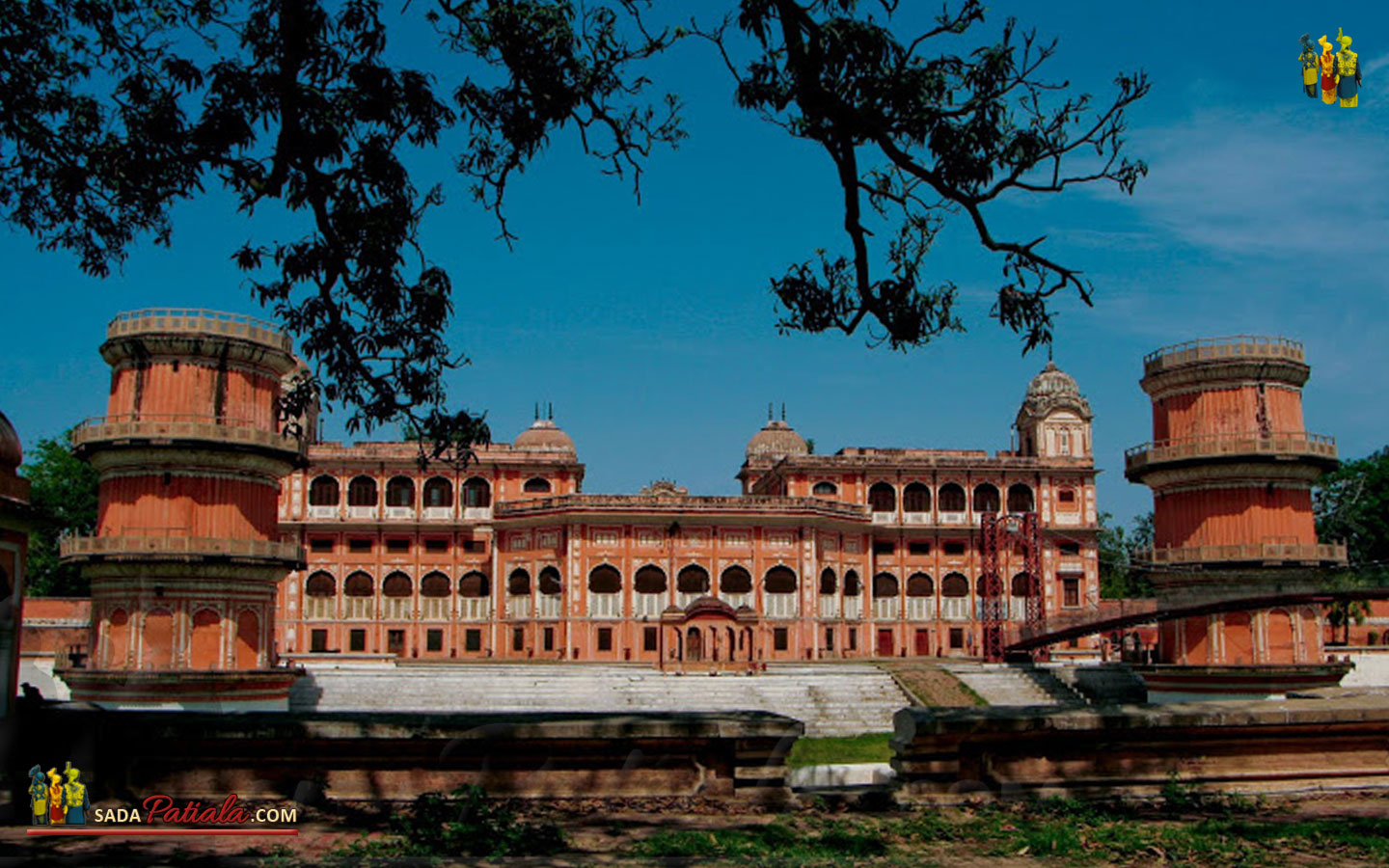
Patiala sheesh_mahal Built under the generous patronage of the former Maharaja of Patiala, Narendra Singh, an aficionado of beauty, in the year 1847, the sprawling three-storied Sheesh Mahal is a fine blend of the modern Occidental and the traditional Mughal architecture. Set in a picturesque backdrop amidst sprawling, landscaped gardens glowing with seasonal blooms that are modeled after the legendary Shalimar Bagh, the estate is a sight to behold. A pretty as a picture suspension bridge that resembles the Laxman Jhoola at Rishikesh completes the picture.
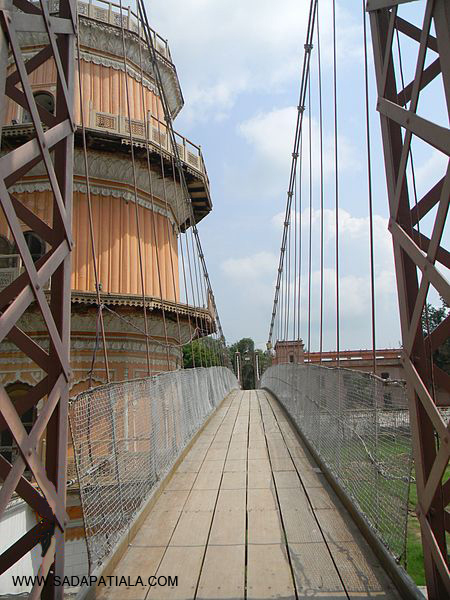
The palace boasts of elegant and lavishly decorated interiors. Ornate mirror works and pretty floral motifs adorn the vibrantly painted walls. Exquisite murals depict scenes from Indian mythology, religious teaches or even illustrate works from the celebrated Indian literature like the masterpieces of Surdas, Keshav Das and Bihari Lal.
Patiala Sheesh_Mehal_Patiala Deft and dexterous craftsmen from Rajashthan and Hiamhal's Kangra Valley were responsible for the aesthetic ambience of the palace. The miniatures from Kangra that depict Jaidev's legendary Geet Govind forms the magnum opus of the palace's collection of antique artifacts ranging from royal apparel to jewelry to portraits.
The palace also houses a medal gallery that showcases nearly 3000 medals from all corners of the globe that date back to the 12th century.
Patiala is a modern city with a domestic airport, a railway station and several good roads. The city has several comfortable and reasonable priced hotels that are mainly frequented by myriad of tourists who flock to see the Sheesh Mahal, resplendent in its royal grandeur, in the pleasant North Indian winters.
Across the small Lake in front of Sheesh Mahal is a magnificent suspension bridge which being a replica of the famous Lakshman Jhoola at Rishikesh, is also named as Lachman Jhoola. It links the Sheesh Mahal with the Banasar Ghar on the other side of the lake. The Banasar Ghar now houses the North Zone Cultural Center and a hall for setting up exhibitions.
Bir Moti Bagh
A 1,600-acre forest on the outskirts of Patiala, The Bir was originally the hunting preserve of the Maharaja. Most of the Bir is still forest, but parts of it house a zoo and a deer park, as well as a pilot project on medicinal plants.
Mall Road
Baradari is the colonial area of Patiala. On one side of Mall road is the Baradari, and on the other is the walled city. All along the vibrant Mall Road are fountains and beautiful paved walkways, as well as goverment offices (all buildings conforming to one architectural style), entertainment spots, including cinema theatres and the Rajendra tank, and temples. (The Rajendra Tank is actually a large lake which once attracted migratory birds in winters. Boating facilities are available here.)
Rajindera Kothi
Kothi is Set in the heart of the Baradari Gardens, this late 19th Century Palace built in colonial style by Maharaja Rajindra Singh till recently housed Punjab States Archives. PUDA is planning to exploit this building as a potential Heritage Hotel.
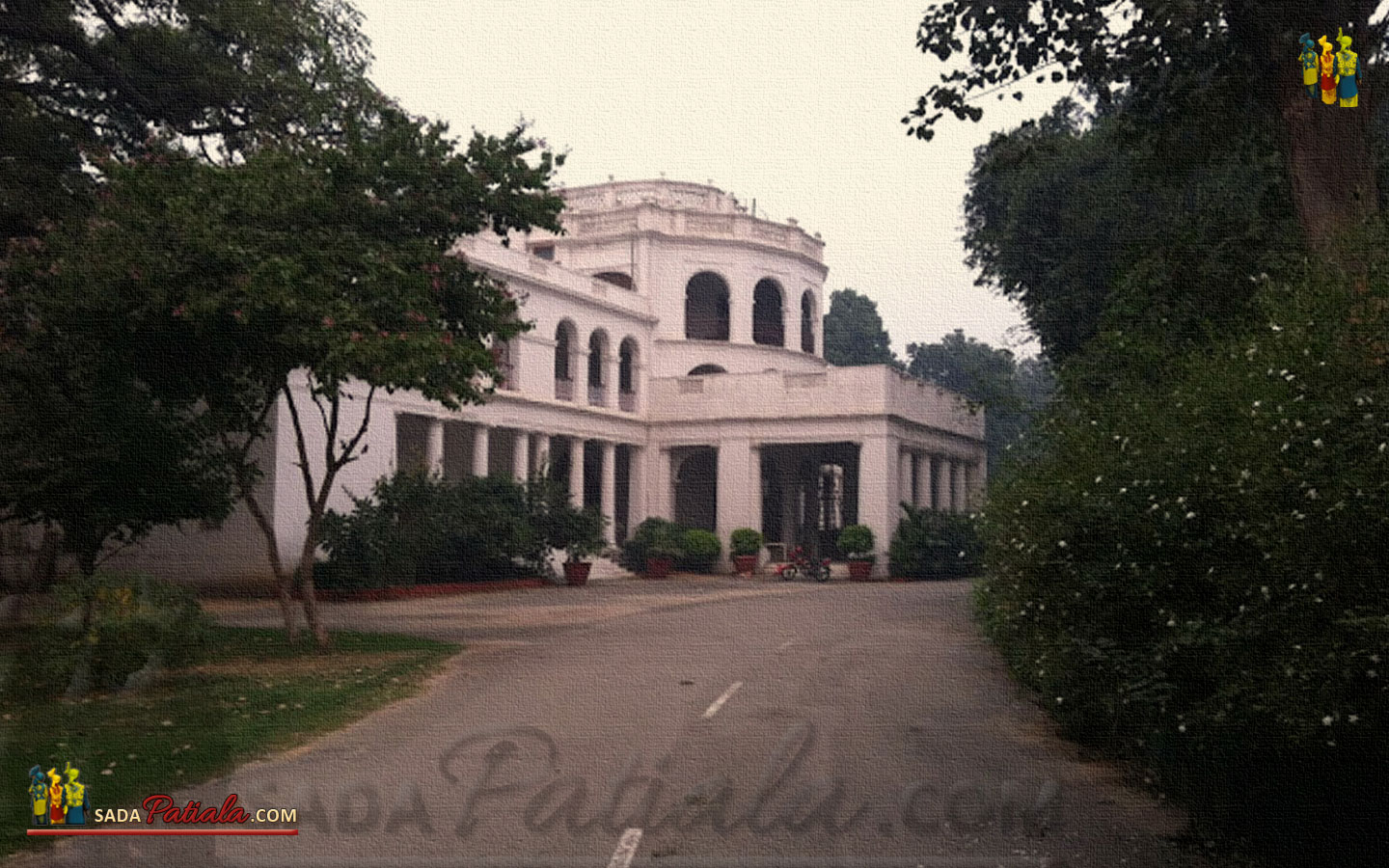
the abode of Punjab’s nobility, Patiala rajindera_kothi the Rajendra Kothi in Patiala may soon throw its doors open to visitors who wish to take a part of history back with them. It is now official that the state government has zeroed in on the magnificent Kothi to kickstart its campaign of rejuvenating the rich heritage of the state.
This decision will help in the conservation of a heritage property. The renovated Rajendra Kothi would not only serve as a brilliant showpiece in the Punjab’s royal landscape but also assume the role of a "practical building", redesigned for leisure in contemporary times. Not just that, it would also set the trend for heritage hotels in Punjab. Till now, the state does not have a single heritage hotel, while there are more than 200 such properties all over India. Rajasthan leads the pack, attracting the largest number of domestic and foreign tourists with its 85 heritage hotels.
Baradari Gardens
The Baradari gardens surround the Baradari palace located in the north of old Patiala city. It is situated in the outer part of Sheranwala Gate.. The gardens, laid under Maharaja Rajindera Singh were planted extensively rare trees and shrubs, dotted with impressive Colonial buildings and a marble statue of Maharaja Rajindera Singh and the Fern House. The 19th century, a replica of the one in Calcutta forms a unique attraction along with quaint Rink Hall.

Patiala baradari_garden The importance Baradari garden can be ascertained from its name. This name was formed with two words of Punjabi Bara and Dar. Bara stands for twelve and dar stands for doors. It means garden with twelve entrances. Baradari gardens were constructed near the Baradari palace. Baradari palace was a residence of Emperor Rajinder Singh. He brought rare species of trees and flowers from different places and planted them in this garden. The big fruit trees the Fern House and the Rock Garden shows his interest towards nature. Another name of Rajinder Kothi is Baradari Kothi because it is situated near the Baradari Garden. Today, the Baradari Palace is a warehouse of important historical documents.
Ijlas-e-Khas
Intended to be the Administrative Secretariat of the princely state, this beautiful building now houses the offices of the Punjab State Electricity Board.
Gurudwara Dukhniwaran Sahib
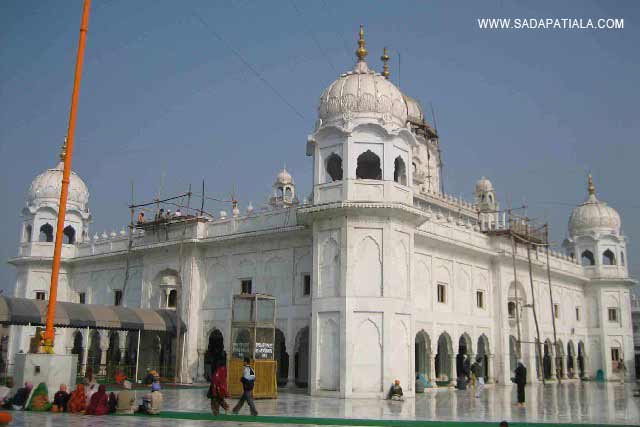
This shrine is situated in what used to be the village of Lehal, now part of Patiala city. According to local tradition, supported by an old handwritten document preserved in the Gurdwara, Patiala Gurudwara_sri_dukh_niwaran_sahib one Bhag Ram, a jhivar of Lehal, waited upon Guru Tegh Bahadur during his sojourn at Saifabad (now Bahadurgarh), and made the request that he might be pleased to visit and bless his village so that its inhabitants could be rid of a serious and mysterious sickness which had been their bane for a long time.
The Guru visited Lehal on Magh sudi 5, 1728 Bikram/24 January 1672 and stayed under a banyan tree by the side of a pond. The sickness in the village subsided. The site where Guru Tegh Bahadur had sat came to be known as Dukh Nivaran, literally meaning eradicator of suffering. Devotees have faith in the healing qualities of water in the sarovar attached to the shrine.
Kali Temple
Shri Kali Mata Temple is situated opposite Baradari garden on the Mall Road of Patiala City (Punjab). Patiala kali_maa_temple_original This Temple was built by the Sikh ruler of the Patiala  State Maharaja Bhupinder Singh who financed the building in his capital of the Mata Kali Devi Temple and oversaw the installation there, in 1936. Bhupinder Singh was the ruling Maharaja of the princely state of Patiala from 1900 to 1938. He was inspired to build this temple and bring the 6-ft statue of Devine Mother Kali & Paawan Jyoti from Bengal to Patiala & he offered First ?Bali? (sacrifice) of a water buffalo to the temple of Kali in Patiala. Because of Temple's awesome beautifulness, the temple has been declared a national monument.
State Maharaja Bhupinder Singh who financed the building in his capital of the Mata Kali Devi Temple and oversaw the installation there, in 1936. Bhupinder Singh was the ruling Maharaja of the princely state of Patiala from 1900 to 1938. He was inspired to build this temple and bring the 6-ft statue of Devine Mother Kali & Paawan Jyoti from Bengal to Patiala & he offered First ?Bali? (sacrifice) of a water buffalo to the temple of Kali in Patiala. Because of Temple's awesome beautifulness, the temple has been declared a national monument.
 State Maharaja Bhupinder Singh who financed the building in his capital of the Mata Kali Devi Temple and oversaw the installation there, in 1936. Bhupinder Singh was the ruling Maharaja of the princely state of Patiala from 1900 to 1938. He was inspired to build this temple and bring the 6-ft statue of Devine Mother Kali & Paawan Jyoti from Bengal to Patiala & he offered First ?Bali? (sacrifice) of a water buffalo to the temple of Kali in Patiala. Because of Temple's awesome beautifulness, the temple has been declared a national monument.
State Maharaja Bhupinder Singh who financed the building in his capital of the Mata Kali Devi Temple and oversaw the installation there, in 1936. Bhupinder Singh was the ruling Maharaja of the princely state of Patiala from 1900 to 1938. He was inspired to build this temple and bring the 6-ft statue of Devine Mother Kali & Paawan Jyoti from Bengal to Patiala & he offered First ?Bali? (sacrifice) of a water buffalo to the temple of Kali in Patiala. Because of Temple's awesome beautifulness, the temple has been declared a national monument.Qila Bahadurgarh
At a distance of one and half kilometer from the main gate of Punjabi University, It is named so to commemorate the 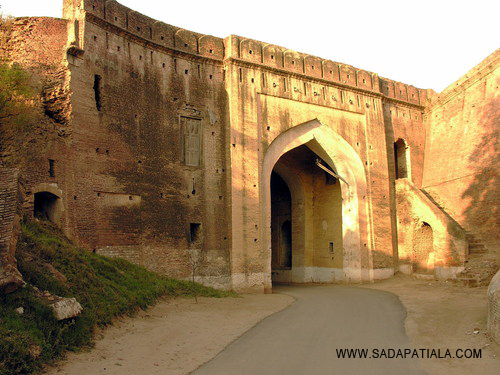 holy memory of Guru Tegh Bahadur who paid visit to this place at the invitation of another holy person Saif Khan Patiala kali_maa_temple_original The four wails of the fort enclose the village Saifabad located on the left-side of the Rajpura-Patiala Road. Saif Khan, a relative of the Mughal Emperor Aurangzeb, after holding several important offices, became a hermit and settled down here. After his death he was buried here. His tomb behind the fort, a structure of 177 x 177 ft. is in a state of neglect. Notwithstanding this, his followers still lit a lamp on the tomb every Thursday. The two inscriptions in the fort testify that the village and the mosque were founded in 1668 during the reign of Aurangzeb. As the tradition goes, Nawab Saif Khan was a great admirer of Guru Teg Bahadur. He invited him to spend rainy season here. His visit is commemorated by two gurdwaras- One inside the fort and the other outside across the road. It is famous as Panj Bali Gurdwara.The Bahadurgarh Fort was constructed by Maharaja Karam Singh during 1837-45 at a cost of Rs. 10, 00,000. Its circumference is one mile, 536 yards and 2 feet.
holy memory of Guru Tegh Bahadur who paid visit to this place at the invitation of another holy person Saif Khan Patiala kali_maa_temple_original The four wails of the fort enclose the village Saifabad located on the left-side of the Rajpura-Patiala Road. Saif Khan, a relative of the Mughal Emperor Aurangzeb, after holding several important offices, became a hermit and settled down here. After his death he was buried here. His tomb behind the fort, a structure of 177 x 177 ft. is in a state of neglect. Notwithstanding this, his followers still lit a lamp on the tomb every Thursday. The two inscriptions in the fort testify that the village and the mosque were founded in 1668 during the reign of Aurangzeb. As the tradition goes, Nawab Saif Khan was a great admirer of Guru Teg Bahadur. He invited him to spend rainy season here. His visit is commemorated by two gurdwaras- One inside the fort and the other outside across the road. It is famous as Panj Bali Gurdwara.The Bahadurgarh Fort was constructed by Maharaja Karam Singh during 1837-45 at a cost of Rs. 10, 00,000. Its circumference is one mile, 536 yards and 2 feet.
 holy memory of Guru Tegh Bahadur who paid visit to this place at the invitation of another holy person Saif Khan Patiala kali_maa_temple_original The four wails of the fort enclose the village Saifabad located on the left-side of the Rajpura-Patiala Road. Saif Khan, a relative of the Mughal Emperor Aurangzeb, after holding several important offices, became a hermit and settled down here. After his death he was buried here. His tomb behind the fort, a structure of 177 x 177 ft. is in a state of neglect. Notwithstanding this, his followers still lit a lamp on the tomb every Thursday. The two inscriptions in the fort testify that the village and the mosque were founded in 1668 during the reign of Aurangzeb. As the tradition goes, Nawab Saif Khan was a great admirer of Guru Teg Bahadur. He invited him to spend rainy season here. His visit is commemorated by two gurdwaras- One inside the fort and the other outside across the road. It is famous as Panj Bali Gurdwara.The Bahadurgarh Fort was constructed by Maharaja Karam Singh during 1837-45 at a cost of Rs. 10, 00,000. Its circumference is one mile, 536 yards and 2 feet.
holy memory of Guru Tegh Bahadur who paid visit to this place at the invitation of another holy person Saif Khan Patiala kali_maa_temple_original The four wails of the fort enclose the village Saifabad located on the left-side of the Rajpura-Patiala Road. Saif Khan, a relative of the Mughal Emperor Aurangzeb, after holding several important offices, became a hermit and settled down here. After his death he was buried here. His tomb behind the fort, a structure of 177 x 177 ft. is in a state of neglect. Notwithstanding this, his followers still lit a lamp on the tomb every Thursday. The two inscriptions in the fort testify that the village and the mosque were founded in 1668 during the reign of Aurangzeb. As the tradition goes, Nawab Saif Khan was a great admirer of Guru Teg Bahadur. He invited him to spend rainy season here. His visit is commemorated by two gurdwaras- One inside the fort and the other outside across the road. It is famous as Panj Bali Gurdwara.The Bahadurgarh Fort was constructed by Maharaja Karam Singh during 1837-45 at a cost of Rs. 10, 00,000. Its circumference is one mile, 536 yards and 2 feet.Panj Bali Gurdwara
Nawab Saif Khan, an admirer of Guru Teg Bahadur, Commemorated the guru's visit by building two gurudwaras, one inside the fort and the other across the road, now known as Panch Bali Gurudwara.
Maiji Di Sarai
This monument in the old city now houses the criminal investigation agency office.






